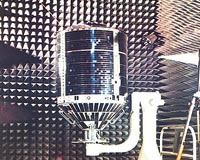 |
Washington DC (SPX) Nov 04, 2009 Launched from Vandenberg Air Force Base, Calif., aboard an United Launch Alliance Atlas V launch vehicle, Oct. 18, 2009, the Special Sensor Ultraviolet Limb Imager (SSULI) developed by NRL's Space Science Division and Spacecraft Engineering Department offers a first of its kind technique for remote sensing of the ionosphere and thermosphere from space. Flying on-orbit the U.S. Air Force Defense Meteorological Satellite Program (DMSP) F18 (flight 18) satellite, SSULI's characterization of the Earth's upper atmosphere and ionosphere provide the necessary scientific data to support military and civil systems. The upper atmosphere affects many systems from global to tactical scales including GPS positioning, High-Frequency (HF) radio communications, satellite drag and orbit determination, and over the horizon radar. "Space Weather can impact systems in both the military and civilian sectors," said Sean Lynch, program manager, NRL Spacecraft Engineering Department. "Observations acquired by SSULI will be processed at the Air Force Weather Agency to generate products to provide a more accurate representation of the atmosphere at a level that can directly affect civilian and military assets." Offering global observations, that yield near real-time altitude profiles of the ionosphere and neutral atmosphere, over an extended period of time, SSULI makes measurements from the extreme ultraviolet (EUV) to the far ultraviolet (FUV) over the wavelength range of 80 nanometers (nm) to 170 nm with 2.4 nm resolution. Building on the successes of the NRL High Resolution Airglow/Aurora Spectroscopy (HIRAAS) experiment flown aboard the Space Test Program (STP) Advanced Research and Global Observations Satellite (ARGOS), SSULI also measures the electron density and neutral density profiles of the emitting atmospheric constituents. SSULI uses a spectrograph with a mirror capable of scanning below the satellite horizon from 10 degrees to 27 degrees every 90 seconds. These observations represent a vertical slice of the Earth's atmosphere from 750 kilometers (km) to 50 km in depth. "The performance characteristics of this sensor are outstanding," said Andrew Nicholas, SSULI principal investigator, NRL Space Science Division. "SSULI measures vertical profiles of the natural airglow radiation from atoms, molecules and ions in the upper atmosphere and ionosphere and enables the development of new techniques for global ionospheric remote sensing and new models of global electron density variation." Models being developed include the Global Assimilation of Ionospheric Measurements. GAIM applies novel and sophisticated data assimilation techniques to space weather forecasting and will become an operational ionospheric model providing real-time ionospheric specification and forecasts for Department of Defense (DoD) and civilian customers. An extensive data processing suite was developed to support on-orbit observations and flight operations. It includes data reduction software using unique science algorithms developed at NRL and comprehensive data validation techniques. After launch, the SSULI sensor, software, and derived atmospheric specification will undergo an extensive validation. After validation, SSULI products will be distributed by AFWA to support operational DoD systems. The Defense Meteorological Satellite Program is a Department of Defense program run by the Air Force Space and Missile Systems Center (SMC). The program designs, builds, launches, and maintains several near-polar orbiting, sun synchronous satellites monitoring the meteorological, oceanographic, and solar-terrestrial physics environments. Share This Article With Planet Earth
Related Links Naval Research Laboratory Space Technology News - Applications and Research
 When Did The First German Satellite Go Into Space
When Did The First German Satellite Go Into SpaceBonn, Germany (SPX) Nov 03, 2009 The first German satellite, AZUR, was launched 40 years ago. On 8 November 1969 at 02:52 Central European Time (CET), which was 7 November at 17:52 Pacific Standard Time (PST), a four-stage American Scout-B rocket took off from the launch site at Vandenberg Air Force Base in California - with Germany's first scientific spacecraft on board. The successful launch and operation of AZUR was a ... read more |
|
| The content herein, unless otherwise known to be public domain, are Copyright 1995-2009 - SpaceDaily. AFP and UPI Wire Stories are copyright Agence France-Presse and United Press International. ESA Portal Reports are copyright European Space Agency. All NASA sourced material is public domain. Additional copyrights may apply in whole or part to other bona fide parties. Advertising does not imply endorsement,agreement or approval of any opinions, statements or information provided by SpaceDaily on any Web page published or hosted by SpaceDaily. Privacy Statement |